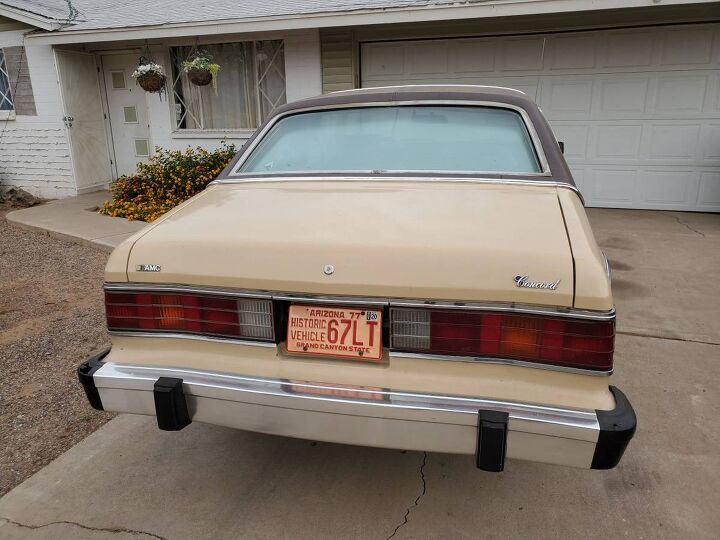Rare Rides: The 1981 AMC Concord Keeps It on the D/L

Vehicles from plucky AMC are always welcome here at Rare Rides. Thus far, the series has featured a Metropolitan, a concept Van, a Matador Barcelona, and a very tasty Sundancer. The latter is a cousin of today’s relentlessly beige Concord two-door sedan.
Ready for some malaise?
The story of the Concord starts out with its father, the Hornet. After the compact model’s run from 1970 to 1977, executives at AMC realized they’d need a compact entry to go head to head with new Fox-body entries from Ford, downsized A-body vehicles from Chevrolet, and everything from Japan. AMC’s bread and butter had long been the compact car segment, so this new car needed to be good. But as ever with AMC, money was tight.
Responsibility for the Concord’s design was handed over to magician Richard Teague, AMC’s favorite designer. What he did was create a Hornet 2.0 on the cheap. Concord utilized the Gremlin’s fenders, mixing them with new sheet metal. The front and rear underwent a redesign, and there was a brand new hood emblem especially for Concord. Reworked visuals accompanied upgraded engineering, as the folks at AMC were scared of the build quality being observed on new Japanese competitors. A reduction in NVH was achieved via an upgraded suspension and additional noise insulation throughout the car. Interior panels were backed with sound absorbing materials, and upper Concord trims also featured a fiberglass acoustic headliner.
A bevy of features were included as standard, and the revised platform meant a bit of additional headroom and rear legroom over the outgoing Hornet. Upon its debut in 1978, AMC billed it as a luxurious compact car. Let’s take a moment and talk Concord with John Davis.
Initial trim offerings were Base, Sport, and D/L. The D/L reflected the tastes of Personal Luxury at the time; buyers who sprung for that trim received a vinyl coach roof in a variety of colors. Other D/L niceties included the opera windows seen on this coupe, color-match wheel covers, velvety upholstery, and wood grain on the dials. By 1981 Popular Science crowned Concord as “the most luxurious of all the U.S. compacts.” A new top trim level bowed that year — Limited. Instantly the best selling model in AMC’s portfolio, the Concord lived a happy life through 1983. By that time, however, AMC’s days were numbered, and Concord was replaced with the Renault Alliance.
Sad!
Today’s Rare Ride is for sale presently in the salt-free location of Phoenix. It’s well equipped with the mid-pack 258 (4.2L) inline-six engine, automatic transmission, air conditioning, and cruise. With 50,000 miles on the clock, this Concord asks $3,500.
[Images: seller]

Interested in lots of cars and their various historical contexts. Started writing articles for TTAC in late 2016, when my first posts were QOTDs. From there I started a few new series like Rare Rides, Buy/Drive/Burn, Abandoned History, and most recently Rare Rides Icons. Operating from a home base in Cincinnati, Ohio, a relative auto journalist dead zone. Many of my articles are prompted by something I'll see on social media that sparks my interest and causes me to research. Finding articles and information from the early days of the internet and beyond that covers the little details lost to time: trim packages, color and wheel choices, interior fabrics. Beyond those, I'm fascinated by automotive industry experiments, both failures and successes. Lately I've taken an interest in AI, and generating "what if" type images for car models long dead. Reincarnating a modern Toyota Paseo, Lincoln Mark IX, or Isuzu Trooper through a text prompt is fun. Fun to post them on Twitter too, and watch people overreact. To that end, the social media I use most is Twitter, @CoreyLewis86. I also contribute pieces for Forbes Wheels and Forbes Home.
More by Corey Lewis
Latest Car Reviews
Read moreLatest Product Reviews
Read moreRecent Comments
- ToolGuy TG likes price reductions.
- ToolGuy I could go for a Mustang with a Subaru powertrain. (Maybe some additional ground clearance.)
- ToolGuy Does Tim Healey care about TTAC? 😉
- ToolGuy I am slashing my food budget by 1%.
- ToolGuy TG grows skeptical about his government protecting him from bad decisions.





































Comments
Join the conversation
I have to admit, even though the coupe featured here is ug-lee with its overwrought opera window, the sedan in the video is beautiful.
I too enjoy these articles on long forgotten and / or orphan vehicles.... Just because you (certainly I) don't want to buy one doesn't make this a bad car or bad article . -Nate